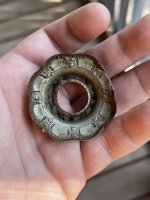Mad Machinist
Silver Member
Hello
Got most of a all aluminum trailer that is 2 x 4 feet in size built to put the crusher on. Also turned the shafts for the rolls say 3 - 6 thousands over size.
Industry standard is .0005 to .001 thousandths per inch of shaft size. So if your main shaft is 2 inches in diameter you should have .001 to .002 thousandths oversize on the shaft.
EDIT AS FOLLOWS:
I had to jump on my laptop as it is easier to type this out. The thermal expansion coefficient for steel is .00000645 per inch per degree F. So if you have a 2 inch shaft for the rolls with .006 interference fit, you would have to heat the roll to 500+ degrees in order to get it together.
2 x .00000645 = .0000129 x 500 degrees = .00645" expansion
The problem with this is most steels start changing properties at around 400 degrees. Most likely heating the rolls to 500 degrees would anneal the steel and make it softer.
So if you follow the industry standard of .0005 to .001 thousandth per inch of shaft size you would end up with:
2 x .00000645 = .0000129 x 200 degrees = .00258" of expansion.
If you stay to the smaller side of the industry standard (.001 to .0015), this would fall right together and WILL NOT come apart without specialized tools and a rosebud to reheat the roll.
By the way, an old gas stove oven works great for heating smaller parts to fit them together. Change the natural gas orifice to a propane orifice, buy a gas grill regulator at your local hardware store, and you can use barbeque grill tanks to run the oven so your significant other doesn't murder you. Put the part in, set the temp, and let it slowly soak up the heat for a couple of hours.
Isn't being a mine millwright fun?
Last edited:


 :
:


